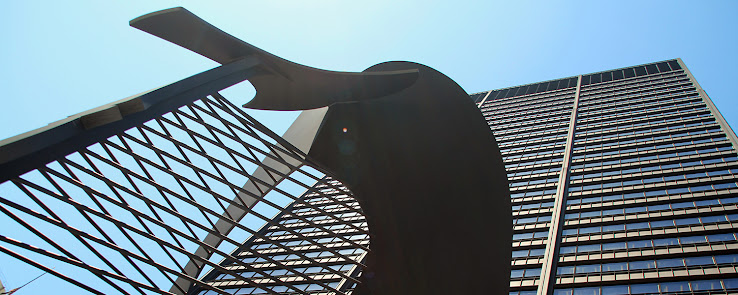Salon Wall..
Richard Harris, taking a Guided Tour [in front of the Salon Wall]..
SALON WALL..
The Salon Wall of Artworks is installed in the style of European Exhibition and Kunskammer ["Cabinet of Curiosity"] of the 1700s and 1800s. Modern museums customarily separate works of arts based on nationality, materials or time period. In contrast the Salon Wall arrangement allows the viewers to see diverse works of art together, and to recognize the shared theme of mortality and its different interpretations. Here paintings are shown next to prints, and hang near masks and headhunters trophies.
A central theme of the exhibition, Vanitas [the hollowness of this world pleasures in the face of death] is represented in artists juxtaposition of skulls with objects that represent the seductive attraction of life and symbols that remind the viewer of the rapidity of the passage of time. Adriaen van Utrech's "Vanitas Still Life" shows a wide range of symbols while a carved English lintel makes the same point with the simple contrast between a skull and fruit. The theme became popular in the 17th century, and the modern examples flow its ongoing resonance for artists. Photographer Vic Duniz' "Skull" [Vanitas]: Pictures of Soil" from 1998, contrasts a skull with a single, crushed flower to make the point of the transitory nature of life...
Vanitas Still Life with a Bouquet and a Skull
by Adriaen van Utrecht [Dutch / 1599-1652]
1643 /oil on canvas
Baroque viewers of still life paintings like these could appreciate the beauty, luxuriousness and rarity of the objects shown, and feel virtuous as they meditated on the warning that the pleasures of the world cannot outlast death. The laurel growing around the skull is a reminder, however, that fame can outwit death and the passage of time, which are symbolized by the skull and pocket watch.
English Renaissance Lintel
1580 /Cotswold limestone with gilding
This architectural fragment contrasts life and death, placing the skull and bones in the center and the cluster of fruits and flowers at the right and left edges. Skulls are a common motif on English tomb monuments, often combined with cherubs, another image linking life with death.
Headhunter’s Trophy
19th century / Naga people of India..
Image below.. paintings are shown next to prints, and hang near masks and headhunters trophies..
Several pieces in the Harris Collection takes a scientific approach to skeleton: Jasper Jones presents skull as though is an X-Ray image. Medical diagrams and modern art use the image to explore biological aspects of human existence. Lucas Samaras's Drawing #18, 1966 draws on traditions of anatomical drawings that extend back to the Renaissance. Many of the items are less about death than the fact that we as human beings are defined by our biology. One the highlight of the group is Tchelitchew's "The Living Shell" 1944, as it combines suggestions of anatomical system with a luminous spiritual glow.
The Living Shell..
By Pavel Tchelitchew
1944/gouche on paper..
Many of the pieces on the Salon Wall have political implications. They point out the consequences of events that are likely to bring about death, and provide social commentary. Skulls and skeletons are powerful symbols intended to warn of danger. Marlene Duman, "Old Fears are Still Valid" is a reminder that apartheid in South Africa in 1987 was still a force. "Victory: the Celebration" 1991, by Robert levers, Jr. is an ominous image of the human cost of victory.
Memento Mori [translated from latin as "remember your mortality"], another major theme of Harris Collection, is explored on this wall. The French momento mori from 1782, depict crowned skulls, reminding the viewer that power and glory cannot deter death - a message identical to the 17th century Spanish "Allegory of Mortality", in which crowned skeleton appears under banners proclaiming that death has stripped them of crown and glory. Often skulls and skeletons confront the viewer leaning on tumbstones in the Odd Fellows print or driving humans towards cemeteries as in the Edward Hagedorn's 1930-35 The Head. Throughout the exhibition, these mememto mori figure are waiting in the background, constant reminder of the life's inevitable end..
Skull Walking Cane..
by Robert Mapplethorpe
1988/ Gelatin print..
Death and the Woman
By Kathe Kollwitz..
1910/ Lithograph
By Jasper Jones..
Memento Mori..
Morbid Curiosity: Richard Harris Collection
Location: Sidney Yates Gallery at the Chicago Cultural Center..
January 28 – July 8, 2012
Curator: Lucas Cowan
Co-Curator: Debra Purden
Director of Exhibitions: Dr. Elizabeth Lee Kelly..
Presented by Chicago Department of Cultural Affairs and Special Events in partnership with the Chicago Office of Tourism and Culture..
RELATED LINKS..
Morbid Curiosity: Richard Harris Collection..















No comments:
Post a Comment